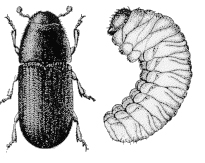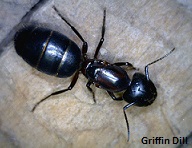Firewood and Insects
Pest Management Fact Sheet #5019
James F. Dill, Pest Management Specialist
Clay A. Kirby, Insect Diagnostician
For information about UMaine Extension programs and resources, visit extension.umaine.edu.
Find more of our publications and books at extension.umaine.edu/publications/.
Introduction
Most of the insects that travel into homes on firewood create only a minor nuisance. Many insects, including flies, mosquitoes, wasps and earwigs, overwinter in spaces in and under bark of logs. Some insect-like animals, such as sowbugs, millipedes and spiders also “hitchhike” a ride on firewood. These hitchhikers can include gypsy moth eggs; hatching larvae create a nuisance. Other insects, such as bark beetles, infest firewood by living under the bark or boring into the wood. The trouble starts when the warmth of indoors signals that it is time to begin spring activities.
- Bark Beetle and Larva
- Eastern Black Carpenter Ant (wingless queen)
- Powderpost Beetle
Description & Biology
Carpenter ants are usually nocturnal but can be seen in the daytime when searching for food or water, or when a colony is overcrowded. Carpenter ants tunnel into wood to increase their nesting space. The queen starts a new colony in unsound, wet wood. Even though carpenter ants that come into homes in firewood are primarily nuisance pests, they may cause structural damage if a new nest is established in the timbers of a home.
Beetles that infest living or freshly-cut trees do not infest dead trees or dry wood. However, they can become a nuisance in homes when they emerge from firewood. The ideal way to avoid these insects is to cut living hardwood trees in the fall or early spring when the insects are in the overwintering or inactive developmental stage. The insects are attracted primarily to the scent of freshly-cut trees; therefore, trees cut in the summer are much more likely to be infested.
There are three families of powderpost beetles (Lyctidae, Anobiidae, and Bostrichidae) that can enter homes on firewood. These insects may infest the structures of homes, wooden tool handles, furniture, etc. Their presence is usually signaled by flour-like wood dust found below small holes in wood.
In general, firewood from dead trees is more likely to be infested with potentially destructive insects. Wood with the bark attached is also more attractive to wood-destroying insects. Many insects attack only wood with bark.
Management
The sooner the firewood is split, the quicker it dries, and the less attractive it is to most insects. Wood not split or wood left outside without covering is likely to become infested. The best place to store firewood is in the woodshed. Wood should be kept off the ground and protected from rain and snow. Air movement through a woodpile aids in its drying.
Poorly-vented basements should not be used to store firewood, especially wood that is not seasoned and dried. Inadequately-dried wood can become moldy, cause unpleasant odors and harbor insects. Humidity released from the wood can also cause mold or rot on structural materials in the basement.
It is best to move no more than a two-week supply of firewood into the home at a time to reduce the chance of insects becoming active. This is especially true with firewood from dead trees. The woodbox should be emptied and cleaned every two weeks.
FIREWOOD SHOULD NOT BE TREATED WITH INSECTICIDES!
When Using Pesticides
ALWAYS FOLLOW LABEL DIRECTIONS!
Pest Management Unit
Cooperative Extension Diagnostic and Research Laboratory
17 Godfrey Drive, Orono, ME 04473
1.800.287.0279 (in Maine)
Information in this publication is provided purely for educational purposes. No responsibility is assumed for any problems associated with the use of products or services mentioned. No endorsement of products or companies is intended, nor is criticism of unnamed products or companies implied.
© 2016, 2018, 2020 | Reviewed: 2023
Call 800.287.0274 (in Maine), or 207.581.3188, for information on publications and program offerings from University of Maine Cooperative Extension, or visit extension.umaine.edu.
The University of Maine is an EEO/AA employer, and does not discriminate on the grounds of race, color, religion, sex, sexual orientation, transgender status, gender expression, national origin, citizenship status, age, disability, genetic information or veteran’s status in employment, education, and all other programs and activities. The following person has been designated to handle inquiries regarding non-discrimination policies: Sarah E. Harebo, Director of Equal Opportunity, 101 North Stevens Hall, University of Maine, Orono, ME 04469-5754, 207.581.1226, TTY 711 (Maine Relay System).




